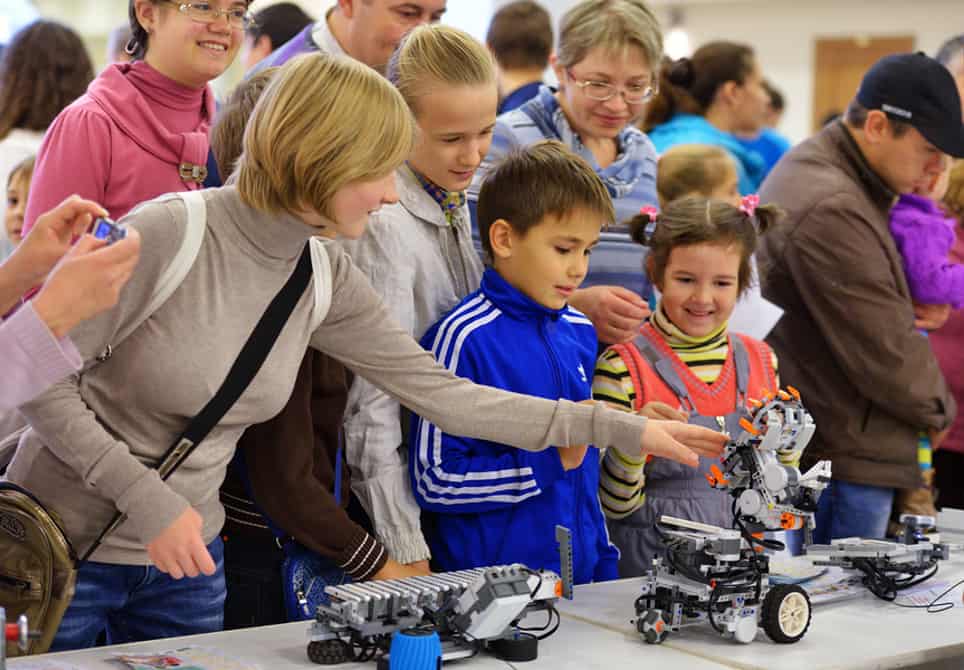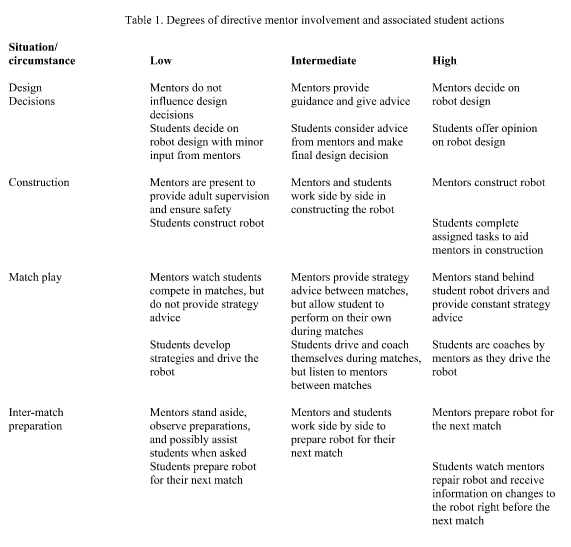The Advantages to Different Mentoring Paths on Robotics Teams

By Dr. Nathan Dolenc
Out-of-school-time (OST) K-12 robotics programs have become increasingly popular in the past decade. Backed by research showing these programs positively influence student attitudes toward science and engineering, it appears robotics is becoming the standard barrier for most activities that merge science, technology, engineering and mathematics (STEM) disciplines.
And rightfully so! Robotics provides hands-on learning, opportunities to work in teams, and the chance to learn new technologies. In addition, many of these robotics programs use competition as motivation to create an environment that mirrors an engineering workplace as students and mentors collaborate, meet deadlines, program design, build and present their work in front of others.
While there is a plethora of literature pointing toward positive student engagement and learning in robotics, there has been little attention spent on mentor involvement and their impacts on student development in these programs. Adult mentors play an integral part in OST robotics programs providing varying levels of guidance to students as they design and build their robots, especially at the secondary level where technology and robot construction are more advanced.
Mentors on robotics team impact student learning and influence their experience the same way teachers impact student learning in their own classroom. Interestingly, many companies in charge of organizing robotics competitions don’t set specific guidelines for how mentors should interact on their team, leading to a wide variation of directive mentor involvement from team to team at every stage of a robotics season.
Before discussing the possible impacts of sustained high or low directive mentor involvement, it would be prudent to cover scenarios that mentors and students experience during a robotics season. Mentors and student spend several weeks strategizing, designing and constructing a robot before competing in game play.
At each of these stages throughout the season, the team makes hundreds of decisions that determine their successes and failures. Who actually makes the decisions could have an impact how students learn and develop. The table below, from the International Journal of Science Education article Hands Off: Mentoring a Student-Led Robotics Team displays the degrees of directive mentor involvement and associated student actions at each stage during a robotics season.

Advantages of High Directive Involvement
A first impression of knowing there is high directive mentor involvement on a robotics teams might be to believe the adults are doing all of the work. However, this also assumes the students are either not present or are sitting back not observing how the team is progressing. Here are three advantage to having this level of involvement on these teams:
1. The overall goal of having high directive mentor involvement is to showcase proper engineering design and construction techniques to students interested in going into STEM fields later on. Having adult mentors play a larger role on a robotics team allows students to see how more advanced individuals (i.e., professional engineers) go about making and implementing their decisions. In a sense, a modeling process occurs where students can observe first-hand how adult mentors make accurate, well thought out decisions.
2. Another advantage of a high directive mentor involvement is having an increased rate of the use of new technologies and knowledge trickling down to students on the team. Mentors are present to provide guidance and direction, which also means sharing expertise advice and knowledge about the latest materials and technologies that could benefit the team.
3. The presence of high directive mentor involvement also provides a structured environment that is beneficial to less experienced students or those who need more guidance. This type of mentor presence also creates a more top-down management style that rarely changes and maintains a similar working environment from year to year.
Advantages of Low Directive Involvement
A first impression of knowing there is low directive mentor involvement on a robotics teams might be to believe the adult mentors are setting up their students for failure. To have this impression is to believe that failure is a bad thing that students should avoid experiencing. However, having adult mentors play a smaller role on a robotics teams also has its advantages:
1. The overall goal of having a low directive mentor involvement is to allow students to bring their own ideas and fully express them through their participation. Students can explore their own ideas through a trial and error process, interpreting and making meaning of their working environment on their own terms with little influence or much bias from adult mentors. Since less experienced individuals (i.e., students compared to professional mentors) are making most or all of the decisions on the robot design and construction, more often than not in the most general terms, there is a higher likelihood that problems will arise throughout the robotics season.
2. Mentors play a person-of-resource role in a low directive scenario. As previously mentioned, mentors provide guidance, but in a low directive scenario their guidance takes the form of formative questioning rather than giving students direct tasks. This includes questioning students after something goes wrong.
3. The presence of low directive mentor involvement provides an unstructured environment that is beneficial to veteran, more experienced students and those that are inherently independent. This type of mentor presence also creates a more bottom-up management style that might be different each year. In other words, students fill in the vacancy of mentor leadership with their own brand of management.
So Which Approach is Right for Your Team?
 The question still remains, “Where do you draw the line between mentors and students when it comes to making decisions?” There are several factors to consider when answering this question.
The question still remains, “Where do you draw the line between mentors and students when it comes to making decisions?” There are several factors to consider when answering this question.
- First, mentors and students need to determine individual and overall team’s level of experience and confidence in completing tasks.
- Second, mentors need to gauge their students’ level of interest in the robotics activity. Students that are truly interested in science and engineering will be completely committed year in and year out. However, some students’ interest may waver depending on the annual game challenge, which changes annually.
- Third, time management is vital in a robotics season. More experienced individuals may need to step in to complete tasks if time is short.
- Finally, mentors and students need to understand their own interpretation of competition. Placing more emphasis on winning will lead to the most experienced individuals making the decisions and completing tasks. However, placing more emphasis on “learning by doing” will lead to most, if not all, students gaining hands-on experience designing and building a robot.
For more, see:
- Utilizing Mentors When They Are Needed Most
- Pick a Mentor – It Will Change Your Life
- Robots & Implications For Life On Planet Earth
Stay in-the-know with all things EdTech and innovations in learning by signing up to receive the weekly Smart Update.




0 Comments
Leave a Comment
Your email address will not be published. All fields are required.